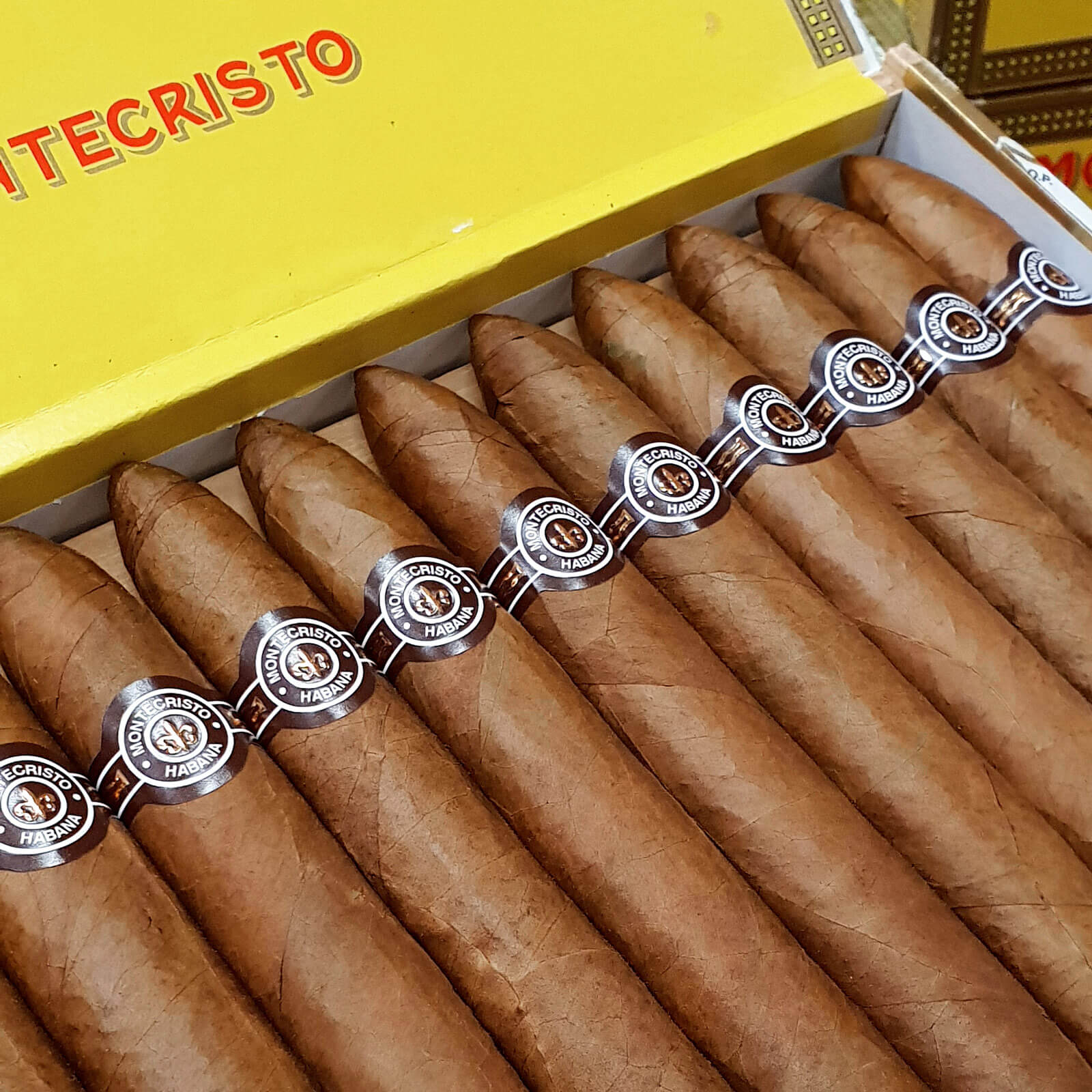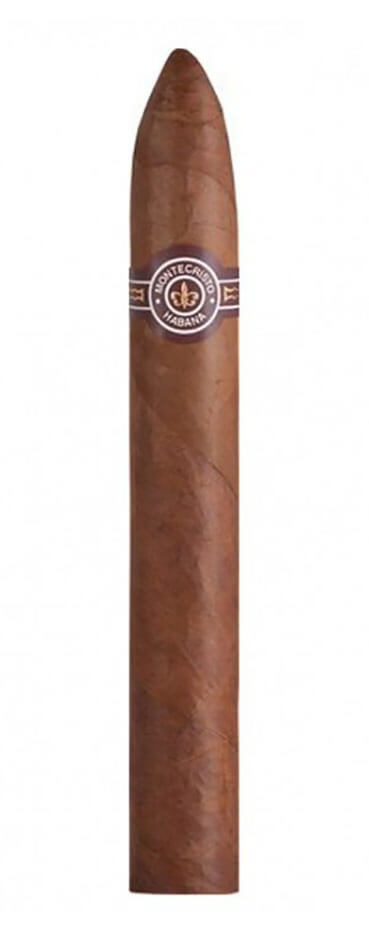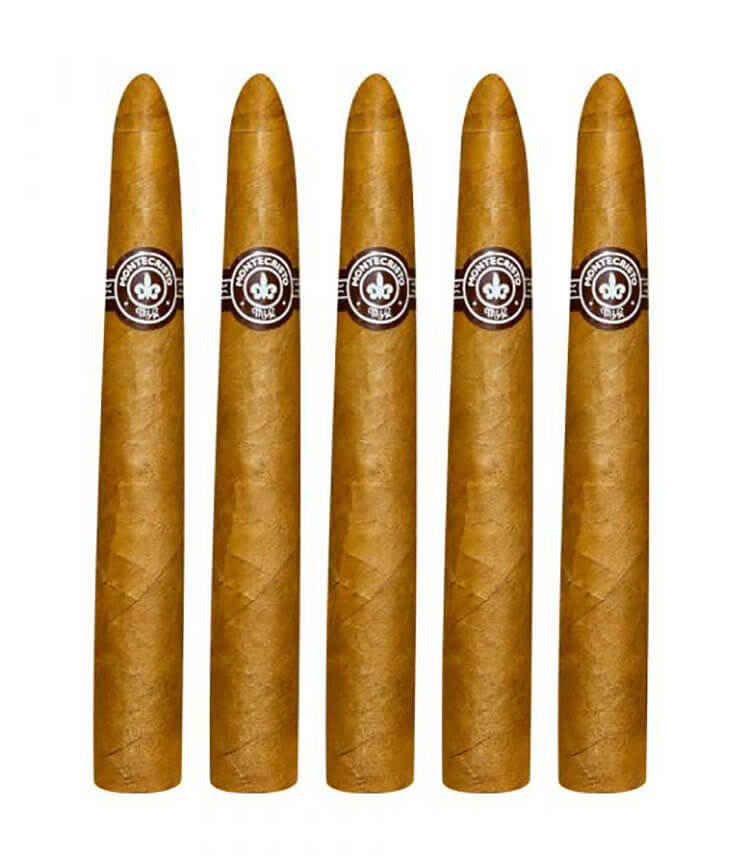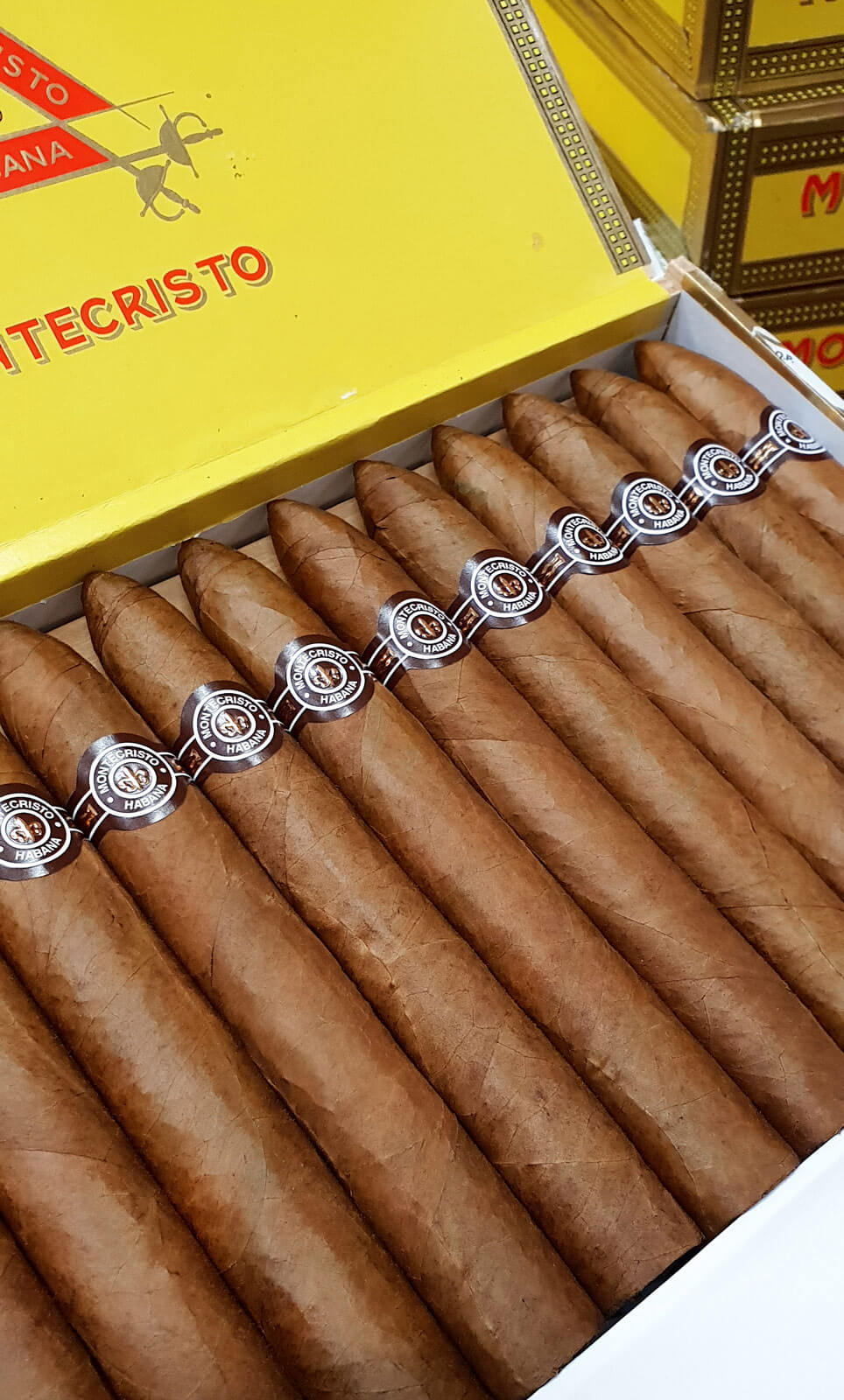Montecristo No. 2 Cigars And A Darker Experience Down An Unmarked, Deserted, Cuban Dirt Track Just Outside Havana | Quill & Pad – Quill & Pad
If pushed to pick a single cigar representing what Havana has to offer, I’m sure we’d get many fine options, but I’d wager that the famed and ubiquitous Montecristo No. 2 ($410/AUD$1,350) would feature heavily on most lists.
For many, the Montecristo No. 2 is not just the king, but the pick of all cigars.

Montecristo No. 2 Cuban cigars
First released prior to the Cuban Revolution that saw Fidel Castro come to power, in 1935, Montecristo No. 2 is available in boxes of 25 and 10. The tech specs are that it is 156 mm in length with a ring gauge of 52 mm.
This is not any Limited Edition, one-off, or regional release. The Montecristo No. 2 is a regular production cigar, one of the most loved Cuban releases, and a cigar that should be readily available without any difficulty. It is instantly identifiable with its tapered end and simple Montecristo band.
A couple of my favorite experiences with Montecristo No. 2s came in Cuba itself, both some years ago.
Getting personal with the Montecristo No. 2 in a bar in Cuba
Every visitor to Havana makes the compulsory trip to El Floridita, Hemingway’s legendary drinking hole, where the great writer would so often share daiquiris with his local friends or visiting stars like Errol Flynn, Spencer Tracy, and Gary Cooper.
It is worth a stop, though one wonders whether the constant stream of tourists or the eight bucks a drink — it is a few years since I was there, so not sure what they cost these days — would have first driven Papa elsewhere.
A few yards away, around the corner from Calle Obispo, is Bar Monserrate. Drinks are much cheaper, the atmosphere livelier, and the cast of characters could well have filled one of Hemingway’s novels.
Enjoying a late-night mojito there early in 2004, a group of us were approached by a friendly local lad who had been hanging around, doing his best to dint the bar’s stocks of cheap rum. Keen to bum cigarettes and possibly a drink, he claimed to be the bouncer, though he was also part-time janitor as he spent half his time leaning on a rarely used broom.
When the bar was later raided, he was one of the few locals allowed to stay, so perhaps he was. The other locals all filed back in shortly after the raid and the place continued as though nothing had happened.

Montecristo No. 2 Cuban cigar
I remember firing up a Monte 2 and offering our new friend one. He declined, preferring the cigarettes offered by one of my mates (as someone who has never even tried a single cigarette in my entire life, and have no desire to start; I was naturally appalled). The entire thing seemed ever so Cuban, but it got seriously Twilight Zone soon after that.
Our new friend was soon telling us that he was certain to be selected in the Cuban boxing team for the Athens Olympics later that year and shaped up, throwing a few shadow punches, before lighting up another cigarette. I thought I had more chance of winning Wimbledon.
We bought him a few rums as he was good company, and he gave me a scrap of paper with his name, Lorenzo Aragon, and address as Cubans are wont to do (not quite sure why they do this but it is a common habit and rather a nice one).
Later, Lorenzo took us to a few dive bars normally frequented only by locals, but I thought little more about it until a few months after the Olympics when I found that scrunched-up note in the depths of my wallet. I thought it might be fun to see if he had made the team, although it seriously never occurred to me that he would – cigarettes, rums, and late-night bars hardly seemed the ideal training regime.
So I did what anyone does and hopped on the internet.
Lorenzo had not only made the team, he won a silver medal! Turns out he was a ten-time Cuban champion and had lost in the ’96 Olympics quarters by a single point to Floyd Mayweather. He had also won two World Amateur Championships, although he had missed selection for Sydney in 2000.
Visiting the bar in the following years, I quickly discovered that Lorenzo was no longer the bouncer but its most honored regular. Cuban royalty.

Montecristo No. 2 Cuban cigars
Cockfighting: a niche, Cuban (male) passion
In Cuba, a land where most people have so little, he is a hero. Boxing and baseball are the island’s major sports, but there is another sport many Cubans follow passionately: cockfighting. But you won’t find it in the guidebooks.
Abhorrent as it is to most of us, cockfighting is as natural to Cubans as Aussie kids kicking a football.
Once prevalent throughout Cuba, when the Revolution banned gambling it was driven underground. Aficionados, however, see betting as integral to cockfighting. Not to wager on a fight would be like going to a casino and asking to play with matchsticks.
Rarely seen around Havana, there are farms in the countryside set up for tourists to witness a sanitized version where claws are covered, and if either bird looks like it’s getting hurt proceedings are immediately halted so no sensibilities are offended.
Keen to see the real thing, though a little apprehensive, I contacted a friend before a subsequent visit to Cuba and asked if there was any chance she could arrange something. I had no response from her to the request and had been in Havana for several days before she casually mentioned that I’d be going to a cockfight the next day. She had no interest herself – very few women attend – but she had a friend who had a friend . . .
The instructions were that I was to wait at the casa particulare we had rented (many Cubans rent their homes to travelers, and these are a great way to immerse yourself in local life away from a more sanitized sojourn in a Havana hotel). Someone would come by to collect me. It could be any time.
It fell through, but a few days later we were on again.
As it turned out, I didn’t wait for long. A beaten up, broken down old Lada pulled up shortly after 9 o’clock in the morning with a driver looking for all the world like a Cuban George Clooney. He spoke no English and never told me his name but flashed a genuinely warm smile at every chance.
As with any Cuban, the most important part of the vehicle is the music closely followed by the horn, and George’s car was no exception. Cuban rhythms blasted forth at airplane-decibel level while we held onto the doors to keep them shut and caught glimpses of the road below through a rusted floor. But the sound system worked and so did the horn, despite incessant use.
We had only gone a couple of kilometers around the backstreets of the neighborhood when we pulled up outside a small house. No mistaking the cackling cacophony emanating from the rear as we headed down the side, past several rusting vehicles of indiscriminate origin, piles of rubbish, and some timid dogs hiding in an overgrown garden, before emerging in a small clearing where four or five guys sat around smoking and tossing handfuls of grain at several chickens tethered to the ground.
Another 30 to 40 were in individual cages. The guys didn’t look overly pleased to see me, but as I was with George there was no problem.
A few minutes later, we were back in the Lada, joined by George’s brother, also sporting a million-dollar smile, and his friend, one of the widest humans I have ever seen. He could have formed a rugby front row on his own.
With his chain smoking, tatts, shades, goatee and tight vest, he could have doubled for Hollywood’s idea of a Cuban hitman. Our new friend had one bird in a bag and cradled another like a child.
Another local followed us on his overladen motorbike, and for the next 40 minutes we picked up and dropped off a series of mates, relatives, and girlfriends. Others gave George wads of cash to wager on their behalf. The birds didn’t make a peep as we continued through the ‘burbs of Havana.
The Russians may have given Cuba money, but they certainly didn’t contribute to the architecture. Suddenly, there were no Russians, no cash, and no aesthetics. Head to Habana Vieja and the Spanish influence for stunning architecture is obvious, but much of outer Havana is a drab place indeed.
Before long, we were on the main highway out of Havana, an extremely wide road in case of the need to move troops and tanks quickly around the country should Uncle Sam invade (seriously).
Then into the surrounding hills and a pit stop for a breakfast burger and beer. George, his brother, and the Hitman, who scoffed one burger while waiting for his other two to be cooked, couldn’t have been nicer, but Aussie manhood took a severe blow when I suggested just an agua rather than an early morning cerveza. The Hitman ignored this and tossed me a couple of Bucanero beers with a big grin.
We continued through the fields and farms before suddenly the Lada pulled off onto an unmarked, deserted dirt track with potholes that would stop most four-wheel drives. We inched our way along: untended growth on one side and on the other a manicured orchard, which usually indicates Israeli capital (their huge investment in the island, including alleged training of the Castros’ security in the absence of the KGB, is rarely mentioned, but interesting given their unsupportive voting record in the UN on Cuban matters.)
At the end of the road, two men stepped out. They were friends of our crew. One called Ivan (I swear I am not making this up) took our birds. We were directed off the road into a makeshift parking area, half of which was filled with Ladas and the rest the wonderful old 1950s cars so prevalent in Havana. More than a few had government number plates.
I asked if it was okay to take photos. It would be generous to call my Spanish basic, but through a few shared words, much waving of hands, and gut instinct we communicated well enough. No problem at all with the camera, I was assured, so out it came. The reaction would have been less frenzied if I’d pulled a gun and started firing. Apparently, they are okay with photos inside at the “ring,” but not where the entrance – or the number plates – might be identified.
We headed along a small track through the undergrowth for 100 yards and came upon a clearing. George arranged for my entry and we were through to where some enterprising farmer had set up a mini covered stadium in the backblocks of his farm. The ring was about 12 yards in diameter, and ramshackle benches, arranged three deep, surrounded it. They looked flimsy but held together, even when several hundred Cubans got very excited and started bouncing up and down. Bouts were already underway. It seems that they go all day, and spectators come and go as they please.
When we arrived, there were already about 100 people in attendance, all Cuban and only two or three of them female. I was the only non-Cuban but no one appeared to mind. The crowd, which doubled throughout the afternoon, was making about as much noise as a stadium of 50,000 football fans in full voice.
Beers, cheap bottles of rum, and even cheaper cigars were passed back and forth. It seemed almost everyone was enjoying a cigar. Farmers had rolled them, selling them for next to nothing to locals. They varied enormously in quality, though they were rarely stellar.
Security was handled by one man: the biggest, scariest human I have ever seen. When things got overheated, as they often did, the bare-chested giant with a few well-placed scars did little more than stand up to restore order. If things really got out of hand he’d wave his hand, and tranquility and serenity would reign. I met him later and it would be hard to imagine a more gentle soul.
Many were there because they owned birds that were fighting – or their friends did. There were local peasants, workers who had made the trek from Havana, and, I was told quietly, a few officials. It was whispered that the only reason that this illegal cockfighting ring is permitted so close to the capital is because it is a favorite of some high-ranking members of the government.
I found myself next to Ernesto, a young doctor with a passion for the sport and cigars – and one of the few people I met on this day with decent English. He told me his pride and joy was a ’55 Chevy. More surprisingly, he turned out to be a big fan of Aussie 400-meter runner Cathy Freeman, who won gold at the Sydney Olympics. The world is a strange and small place.
I handed Ernesto a Montecristo No. 2 and lit one myself. His eyes widened and he told me that he was amazed that I had found such quality on the street. I explained that I bought them in one of the local “official” cigar stores, but he was not aware of them.
Most of the crowd would be lucky to earn more than $8 a month. Even the doctor would only be earning around $15-$30 a month. Which means that such cigars are an impossibility for locals. During my visits to Havana, I have met numerous taxi drivers who were once doctors and even some international airline pilots. They all gave it up as those jobs paid so poorly. Any position that provides contact with foreigners is much more highly desirable as it offers the opportunity for tips and therefore an income far in excess of that provided by the government. Surely, that cannot continue.
Ernesto was a terrific bloke and he assured me that in his entire life he had never experienced a cigar so superb. It does seem somewhat iniquitous that a doctor in gainful employ cannot afford a Montecristo No. 2 in his own country – or even be aware that there are stores selling them to visitors. Finally, he finished the Monte and showered me in gratitude. I handed him another to enjoy later.
During a bout only the birds, the owners, and one official are allowed in the ring. But often emotion swept the crowd and they rushed across the pit to argue. When this happened, our large friend would stand up and the ring would quickly empty.
When a bout was over, the ring filled as though at the end of a heavyweight boxing match with large amounts of cash changing hands, though how anyone keeps track of it is beyond me – it is even more chaotic than kickboxing fights in the backstreets of Bangkok.
Often, the only way to clear the ring is to start the next fight. Embarrassed losing owners screamed at their dead or dying birds, which seemed overkill. Not far from the ring was a roped-off section selling drinks and lunch – chicken sandwiches. No one seemed to appreciate the irony of this. I started to wonder if this was the fate of the losers.
If they were “fighting virgins,” the birds were prepared for their fights by having their back talons removed from each claw, apparently painless, and a specially molded spur attached.
Experienced birds simply have the plastic spur tied on. Birds are graded by the length of these spurs and watching an expert fasten them is just like watching a fisherman tying a fly. They even keep the different spurs in small boxes, much like a fisherman might keep his favorite flies.
Each bird has a line shaved up its back before the fight. The reason is unclear, but it seems the Cubans believe it channels energy. For each bout, a double box contraption is lowered from the roof, and the combatants are placed in adjacent sections with a barrier in between so they cannot see each other, ensuring they remain calm until the bell. At that moment, the barrier is lifted, the birds find themselves facing each other, and the fight is on.
Bouts can last a minute or an hour. Apparently, there is a provision to call a halt after 20 minutes, but it would be a brave official who dared to do so. This is a cruel sport. Sometimes birds will circle each other, sizing up their opponents and seeking openings. Other times, they fly at each other as though deranged.
One bout will be ferocious; the next it seems more likely that the birds will die of old age rather than in the ring. Birds have been known to completely lose interest in each other.
Often, bouts need to be restarted and the owners give their charges a form of mouth-to-mouth, which supposedly helps revive the wounded. Sometimes, one will chase the other for several minutes, rather like an old Foghorn Leghorn cartoon. But in a good fight, each bird tries to get on top of the other.
Beaks and talons flash, and the winner will pin its opponent to the sawdust. It is surprisingly rare for the loser to be killed, despite what myths and conventional wisdom would have us believe. The loser, if it survives, can fight again but one suspects more often a disgraced bird is headed for the pot. The winner will fight again in a month.
For reasons I didn’t want to know, the winning owner usually spat on the bird’s behind and sometimes inserted his finger. It seemed to calm the bird. If a bird survives around half a dozen fights, it is usually retired as a hero and becomes a family pet, often treated better than the owner treats himself and his family.
How my bird fared
Finally, it was our turn. For reasons I never comprehended this fight has attracted far more interest than any other, and when the birds were released the noise was deafening.
Our bird, in his first fight, was dwarfed by its giant white opponent, surely the Mike Tyson of chooks. But ours was from Pinar del Rio, home of the greatest tobacco on the planet and apparently famous fighting cocks.
Soon, the white bird was throwing its weight around and things looked grim. White pinned ours but, as can happen, seemed unaware what to do next and didn’t finish the job. It was a fatal mistake and in a flash of claws and feathers it was all over. White lay debilitated in the dust, and pandemonium was unleashed. My friends were waving fists full of cash (which in truth probably totaled only a few bucks) and the bird was paraded around like he had kicked the winning goal at the World Cup final. The bird was covered in kisses and I was swept up in the whole thing, even planting a big kiss on the winner’s head. The Bucanero flowed, my friends were beyond happy, and the bird was declared a bueno caro.
A little later, the crescendo reached with our bout was eclipsed. Two birds flew at each other in undisguised fury from the moment of release. Neither took a backward step. Usually, dominance is established early and then the bout heads to its inevitable conclusion. Not here.
Sawdust and feathers flew as the warriors went at each other time and time again. The crowd was at fever pitch. This must be a little like being front row for one of the Ali-Frazier fights. We were all on our feet cheering and even my heart was pounding.
I said to Ernesto that this is what it would have been like if ever Ali had fought Teofilo Stevenson, the legendary Cuban heavyweight. Ernesto agreed. Still the birds went at each other with incredible energy. This is why the crowd was here. For people with so little in their lives it is easy to understand the excitement cockfighting brings, even if horribly cruel to us.
Finally, exhaustion set in and there was a moment when both birds were on the dirt, straight out of one of those Rocky and Apollo Creed fights when both boxers are on the deck. Then they were up and going again. Their fight spilled out of the ring and they kept at it under the benches before being dragged apart and returned.
Finally one bird got the upper hand, pinning his opponent but for the first time seeming puzzled as to what to do next and actually pulling the other cock to its feet; this was a mistake as the positions were soon reversed, but he escaped. These were gladiator chickens. Eventually, both birds collapsed again.
A winner was declared. I don’t know which or why, but the crowd was close to insanity. I was delighted as both birds survived and will fight again or be retired. No emperor would’ve dared to give the loser the thumbs down.
Finally, the afternoon sky started to darken with an impending storm. We departed, limping home in the blaring Lada while my still ecstatic friends continued to kiss their bueno caro. They drove me past one of the mansions where Fidel Castro used to stay on occasion – no one seemed sure if Raul also used it. Fidel was said to move residences almost nightly, among his various mansions, for reasons of security. I’m told the locals could pick which mansion was in use by the increase in military personnel around it.
Cockfighting is an undoubtedly barbarous sport and nothing here is intended to give it even tacit approval. But in Cuba, where the people are denied so much, where they have so little beyond music and dancing and their amazing love of life, it seems churlish to criticize from afar. They take what small pleasures they can and enjoy them to the fullest. Meanwhile, the Castros and their cronies have their mansions.
It was an extraordinary day, just one more piece in the puzzle that is this amazing island.
Forgive the digression.

Montecristo No. 2 Cuban cigars
Montecristo No. 2
A good Montecristo No. 2, and it seems that most from 2019 fall well within this definition, is a wonderful cigar. Chocolate. It evolves throughout, moving from hot chocolate to dark chocolate to cacao powder and back again.
It slowly increases in intensity but remains balanced. You’ll also find notes of leather, cinnamon, wood, gentle sweet spices, and more. They age beautifully, but also smoke wonderfully well when young. Today’s example? 95.
The Montecristo No. 2 is a cigar that should be represented in every aficionado’s humidor with both young and aged examples. Montecristo No. 2: a Cuban classic. I hope Ernesto has had the chance to enjoy many more.
You may also enjoy:
Montecristo No. 3 Cuban Cigars: The Count Would Be Pleased
Montecristo Línea 1935 Leyenda Cigar: The Closest Thing To The Second Coming?
Hoyo de Monterrey Escogido Cuban Cigars: The ‘Chosen’ Few
Partagás Lusitania Cigars: Reliably Top Notch
Hoyo De Monterrey Double Corona: Mind-Changing Flavor
Trinidad La Trova Cuban Cigars: Exceptional In Every Way
Cuba’s Habanos Añejados Program Up In Smoke: No Evolution And No Complexity